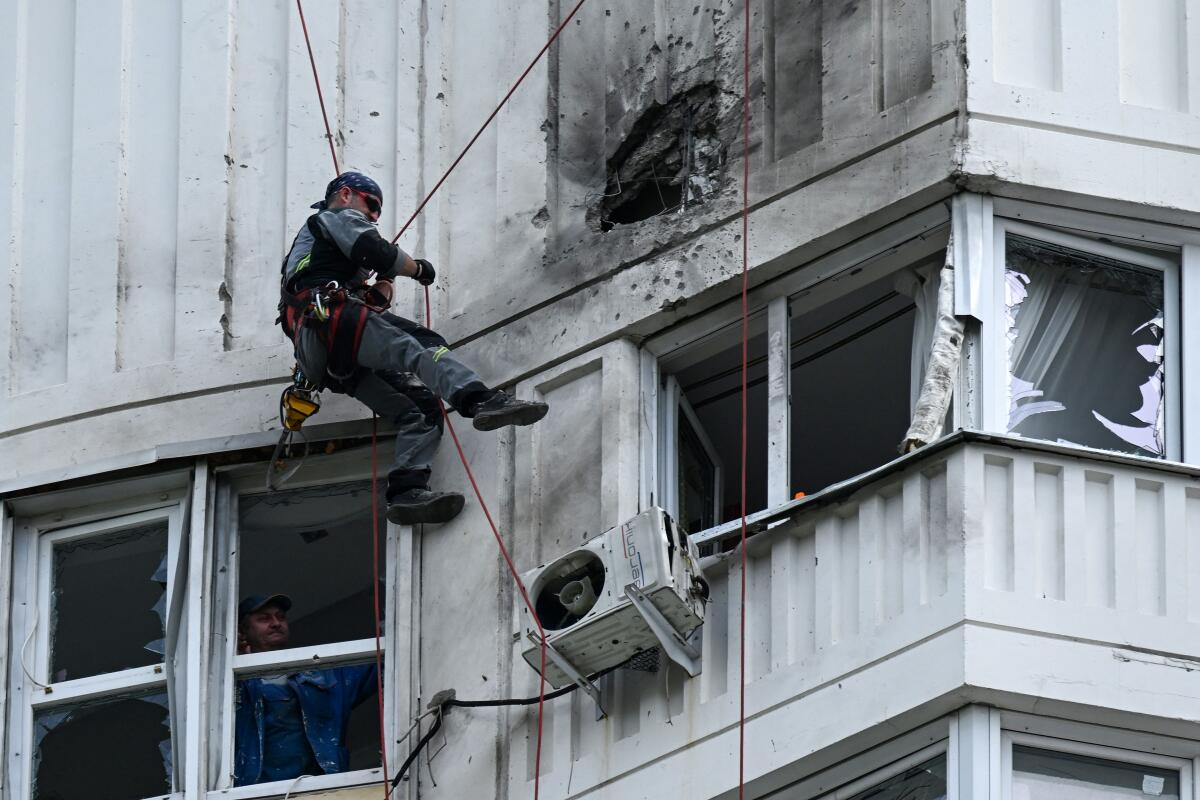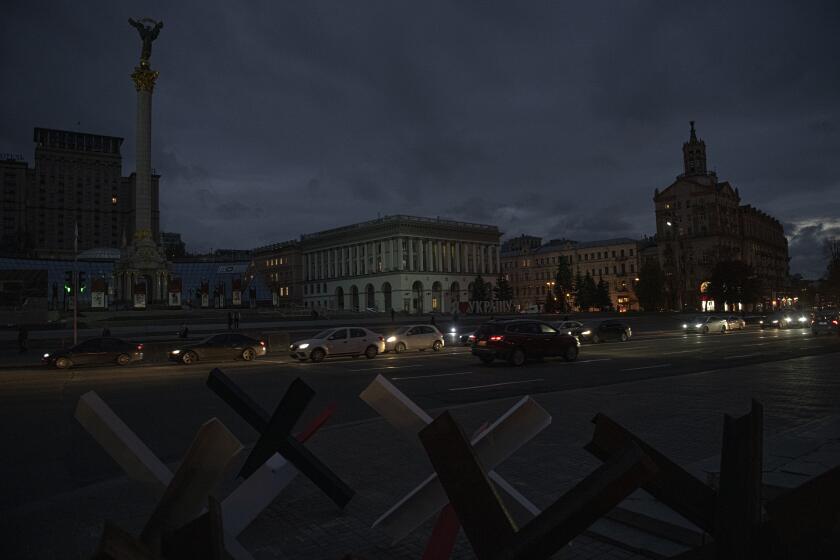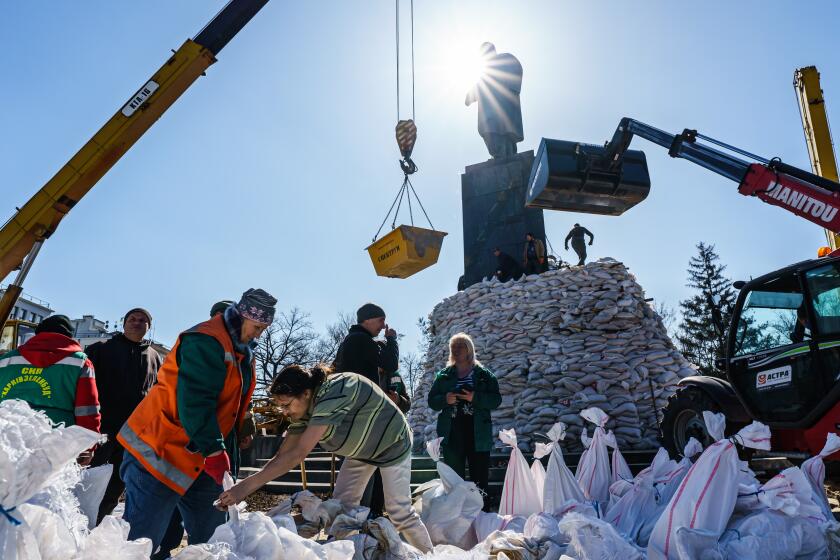Opinion: Why Ukraine may have launched an unprecedented drone attack on Moscow

- Share via
Ukraine is suspected of conducting strikes in Moscow on Tuesday, reportedly resulting in damage to several residential buildings and casualties. While Kyiv is not unaccustomed to aerial strikes, this incident represents the first reported attack on civilian areas in the Russian capital since the war began in February 2022.
Only grainy photographs and video of the systems used in this week’s alleged attack in Moscow have circulated. Russian authorities blamed Ukraine for the attack, but Ukrainian officials have firmly denied involvement.
Whether this strike was conducted by Ukraine remains uncertain, but it has become clear by this point in the war that clever use of drones is a point of pride for Kyiv. Ukrainians have even written folk ballads dedicated to their drones and set up “dronations” or crowdfunding efforts to purchase them for the military. Beyond drones’ practical applications, their symbolic significance is akin to the flags, airlines and Olympic teams that serve to underscore modern states’ legitimacy and progress. Recent estimates that Ukraine loses 10,000 drones, known as uncrewed aerial vehicles, or UAVs, each month — suggest Kyiv is leaning on these devices in the way traditional warfare relies on guns and bombs.
Students at Kyiv National University have no heat and scarce electricity:’ We won’t be sad this fall. Only Russians will be sad.’
We could interpret Ukrainian drone attacks as more of a psychological strategy rather than a tactical one. Ukraine has volleyed the fight to Russia’s capital, exposing Russia’s vulnerability and psychological unpreparedness in the face of the attacks. Russia has largely pitched the conflict as a “special military operation” and not a war, so the encroachment into Moscow challenges this notion, capitalizing on domestic criticism within Russia. Moreover, the alleged use of domestically produced drones in the attack reinforces the idea of Ukraine’s self-sufficiency and determination in the face of adversity.
Throughout the last year, Ukraine has demonstrated exceptional prowess in leveraging advanced, emerging and even long-standing technologies in novel ways to gain a competitive advantage. Ukraine produces its own drone, the UJ-22 Airborne UAV, which some experts suggest could have been employed in this week’s attack in Moscow. Others argue that loitering munitions such as the UJ-31 Zlyva are more likely candidates. Loitering munitions, often misleadingly called “kamikaze” or “suicide” drones, differ from drones in that they are intended for single use and are not designed to survive their missions. Their ability to linger before engaging targets allows them to be relatively stealthier.
While the exact system used in Moscow remains fuzzy, the significance of using either of these capabilities in these attacks remains consistent. Over the last few decades, traditional military drones have often been limited to reconnaissance and surveillance or targeted strikes. In the first days of the conflict, Ukraine broke this convention, lifting the rather unexceptional, loud, slow, lumbering Bayraktar TB2 UAV produced by Turkey to new heights of infamy. It used them successfully to target slow-moving Russian tanks, armored vehicles, patrol boats and, more creatively, as a distraction to sink larger flagships. Nearly a year later, the TB2s have all but disappeared from the battlefield as electronic warfare capabilities have improved, rendering them more vulnerable than updated systems. Ukraine demonstrated a creative use of drones, no longer treating them as precious assets limited to targeted strikes.
These kinds of military capabilities have evolved to become more than just effective tools for national security. They now serve as instruments for projecting force, conducting propaganda and managing perceptions. Their role today is reminiscent of 19th century gunboat diplomacy, in which states would visibly position warships near the coastlines of adversaries as a means of intimidation and coercion to compel nations into making favorable concessions.
This new approach is a paradigm shift in how these systems have been used historically in other wars as well. Previously, we’ve seen the United States, for instance, use drones extensively to carry out targeted strikes against terrorist organizations. For Ukraine, drones are a mainstay in battle.
Ultimately, the benefit of drones in this attack is that they limit the risk of escalation. Despite Russian President Vladimir Putin making veiled threats, stating that the recent attacks were designed to provoke, the response from Moscow to the strikes has not significantly deviated from the norm. Drones and loitering munitions can be trickier to identify. This allows for a level of deniability that has permitted Ukrainian allies such as the U.S. greater leeway to navigate the balance between continuing to provide military aid while simultaneously reiterating it does not support attacks inside Russia, with controlled blowback.
Above all, the war is about Russia trying to gain control over Ukrainian identity and history. In that, Putin has failed.
According to researchers, UAVs appear to lead to “remote-controlled restraint”: Because drones cost less and there’s no human on board, decision-makers are less likely to launch “escalatory responses,” than, say, the more emotional response that would result if a fighter jet were shot down. However, what escalation dynamics could look like for loitering munitionsis less clear .
These factors keep escalatory dynamics fairly controlled, despite the significance of such an attack.
A single technology alone will not fundamentally shift the war’s trajectory. Instead, the ongoing utilization of advanced and emerging capabilities such as UAVs and loitering munitions underscores Ukraine’s military innovation and adaptability throughout the conflict, opening up new avenues to wage warfare that we may not have seen yet.
Lauren Kahn is a research fellow at the Council on Foreign Relations. @Lauren_A_Kahn
More to Read
A cure for the common opinion
Get thought-provoking perspectives with our weekly newsletter.
You may occasionally receive promotional content from the Los Angeles Times.












